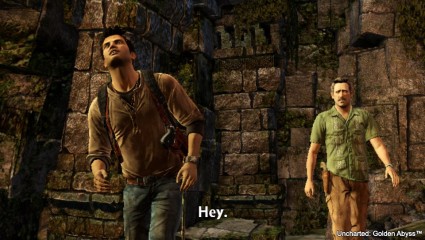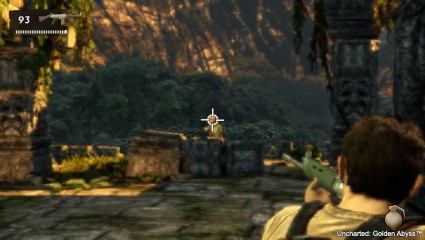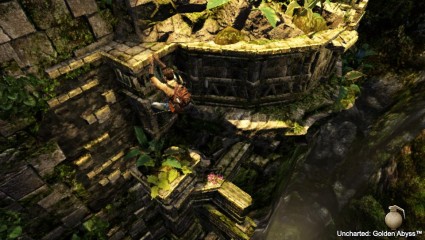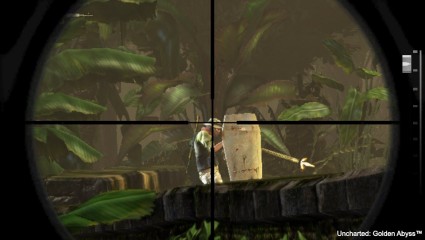Reviews
Uncharted: Golden Abyss
March 5, 2012, Author: Andy Corrigan
Uncharted was initially a strange beast for me. I was intrigued by early footage, showing off Tomb Raider-style exploration and climbing crossed with Gears of War-style gunplay. As much as I wanted to play it, I couldn’t help but think that it wouldn’t be half as good as it looked. I was wrong. It was better.
Not only did it successfully meld exploration and climbing with intense, involving gunplay in a way that Tomb Raider never quite managed, it also had an engrossing storyline that was solidly directed and oozing at the seams with great production value. They took believable personalities and put them in extraordinary situations; characters who started unlikeable but grew in warmth and heart as the game went on. It was an easy game to fall in love with.
Since then, the series has seen two highly successful follow-ups that have dwarfed the original in scope. It’s a Playstation mainstay and a huge franchise for Sony. It’s hard to imagine a Sony console without it.
That’s why the announcement of Uncharted: Golden Abyss as a Vita launch title was a surprise to no one, but it was slightly worrying that Naughty Dog would not be handling development, instead passing the torch to Sony’s Bend Studio.
Bend at least come with decent handheld pedigree, having made a new home for the Syphon Filter series on PSP and handled another big Sony franchise with Resistance: Retribution in 2009.
Have they treated Nathan Drake with the same level of respect in this Vita prequel?
Sony’s golden child…
As a prequel to the PS3 games, Golden Abyss fails to tell you anything new about Drake. We find him in the vague location of ‘Central America’, where his old friend, Jason Dante, requires help investigating the apparent murder of a Spanish expedition by mysterious natives over 400 years ago. At the dig site, Dante runs into trouble with the local authorities, namely a former General-come-drug runner known as Guerro.
Dante leaves Drake in the hands of his partner, Marisa Chase, while he goes to clear up any confusion. Drake quickly discovers that her and Dante have an uneasy working relationship. From here, Drake and Chase are attacked by Guerro’s men, as he is left to discover the truth of Chase’s stake in the area, Dante’s motives and just what happened to the doomed Spanish expedition.
It sounds awesome, doesn’t it? Only it’s not really; it’s a little bland. It also drags occasionally, and the new characters are poorly realised when stacked against the likes of old favourites like Elena and Sully. Still, Drake himself has been handled with the utmost of respect by Bend, and he’s represented well in his usual fashion, with boyish charm and awesome one-liners intact. On the whole, Golden Abyss just sadly lacks the excellent characterisation that the other games are famous for.
A large problem is that a lot of the dialogue is contextual and based on what you’re doing; there’s no real sense of any connection between our key trio, which is a massive shame as the relationships that Drake has are paramount to the home console experience. It’s no surprise, then, that when Sully makes an appearance around the halfway point, the narrative and writing takes a massive step in the right direction.

The story doesn’t wholly feel like Uncharted until Sully makes an appearance.
Rubbing one out
Thankfully, for most part at least, Golden Abyss is classic Uncharted gameplay. You’ll be climbing up and down ruins, engaging in drawn out stand-offs with many enemies, and doing all the things you’ve come to expect from Nathan Drake. Climbing is as fun and intuitive as ever, while gunfights have never felt so slick or so alive in the palm of your hands, all courtesy of those awesome little analogues. Actually getting to play Uncharted on a handheld is truly an amazing experience, and no more so is that true than in the flowing stop ‘n pop combat.
Obviously, Bend have tried to make decent use of the new feature-set. Some of these decisions work extremely well and enhance the Uncharted experience, some of them detract from it, and unfortunately it’s mostly only the good stuff that’s completely optional.
So what works well? A lot of the touchscreen implementation is pretty sweet. For example, instead of climbing the old-fashioned way, you can simply use your finger to trace a path along the ledges to make Drake automatically climb to where you want, or you can tap a ledge to make him jump to it. This is smart, optional implementation, and while I’ve certainly used the traditional method for most of my first playthrough, I have been using a combination of both here and there.
In combat, you’ll use the touchscreen to pick up weapons when one is at your feet. This is quick, painless and helpful in the heat of battle. My favourite combat feature, though? Using the gyroscope to fine tune my aim, making those headshots nice and smooth, especially when using a sniper rifle. I also liked the stealth attacks, where you find yourself behind cover or behind someone, and a quick tap of the enemy will see them disposed of quickly and easily.
Throughout you’ll find the need to take charcoal rubbings of statues or artifacts to solve puzzles. This works well and as you’d expect, rubbing your fingers over the beautiful screen. You’ll also need to clean some of the artifacts you find, rotating them using the back touch-pad, while rubbing the dirt off on the front. Other times might see you piecing together torn pieces of paper or rubbings you’ve already taken.

This level of gunplay is unprecedented in the handheld arena.
Drake’s journal is a little more interactive, listing all the things you need to find or have collected. Listed in here is everything you can find; some are simple ‘find item and press button’ affairs in the environment, usually related to stones you need to find, while some require a bit more thought and relate directly to the goings on in the story. These are things like finding the belongings of Chase’s missing grandfather, or evidence of activity at a mining facility. There are even things to find in cut-scenes, as you tap the giveaway flashing items in the background to add them into your journal. It’s certainly better than typical quick-time events.
One of my favourite features is the photography. As part of the collection process, you’ll need to recreate photos. These involve finding landmarks or key items and then photographing them from the perfect distance and zoom, matching it up to the black and white copy that’s in the relevant journal page. The game signposts these well, but subtly. When you’re in the right area, the onscreen menu to the right of the screen becomes visible with the camera icon highlighted.
A lot of these features are ultimately pointless but harmless fun. Often they make for a nice change of pace while also fortifying the idea of Drake as an experienced archaeologist. This I liked.
On the other hand, the bad design decisions don’t quite derail what is a fun experience, but they certainly tug on the enjoyment here and there. For example, mêlée attacks in the midst of combat is handled by tapping the enemy a few times when close enough, then following with an awkward and slow quick-time event, sweeping your finger in an indicated direction. It’s poorly executed and serves only to obstruct your view mid-firefight. It works in stealth because it’s a quick, one-time press, but this is at the opposite end of the spectrum and works against you with enemies all around and firing on you.
Similarly, there are times when you’ll need to whip out the machete and cut down some bamboo to progress or find secrets, and in doing so you trigger a terrible touchscreen QTE where you trace the direction of onscreen arrows. All it leads to is delay and boring animation. At least when this is used to give a colleague a leg-up to a higher ledge or to move an obstacle, it’s a fairly quick process.
Another option that doesn’t quite hit the mark is that you can climb ropes by stroking the back touchpad. It technically works and doesn’t hamper anything particularly, but I just don’t see why you would. Your thumb is already on the left stick; just push up. It’s much easier and quicker than relocating rested fingers. It’s more of a ‘because we could’ feature than one that enhances gameplay. Ditto for boat rowing.
Also terrible, but not strictly Bend’s fault as Naughty Dog have already done it before, is using the gyroscope to balance when crossing beams or fallen tree trunks. It didn’t work on Drake’s Fortune and it still doesn’t work now. The implementation doesn’t even make sense; you only need to use it when Nate stumbles, but unless you’ve got a crooked neck, you’re already holding the device horizontally and are therefore already balanced, but now you need to wildly swing from side to side to stay centred? Dumb.
Thankfully, these particular issues come few and far between and they’re never constant. They’re occasional annoyances rather than full on complaints. The core gameplay of Uncharted is here; the combat and climbing are almost perfect in their representation, while the puzzle elements are probably stronger than ever. Even with issues, it’s still certainly one of the stronger games in a high-quality launch line-up.

The core elements of Uncharted are here, and are just as awesome.
All that glitters…
While the other week I reviewed one of the best-looking handheld games ever in Resident Evil: Revelations, Golden Abyss blows it out of the water on every level, especially given their respective scopes. Uncharted on Vita looks almost as good as Drake’s Fortune did on PS3, and despite being an early title for the system, that was no ugly game.
Environments are detailed, rich and lush with foliage, deep jungle areas are so dense you can almost feel the grime and dirt, while bugs buzz around Drake’s head. The lighting looks amazing too, especially as sun beams through the beautiful scenary and over the top of temple ruins.
Character models are also top-notch, with Drake in particular indistinguishable from his PS3 counterpart. Animations are spectacular for most part, thanks to Naughty Dog giving Bend access to their mo-cap studio, although some of the touch screen QTEs leave some of the resulting animations looking a little stunted and awkward at times.
There are some occasional glitches too. For example if Drake leans over to catch his breath, his hands eerily go through his thighs. Thankfully this type of clipping is about the worst you’ll see in what really is the visual showcase game of the launch.
Gold records
Golden Abyss also sounds great. The voice acting, in spite of a weaker plot, is pure Uncharted. Dante and Chase aren’t great characters, it’s true, but vocally they fit into Drake’s world just fine. Drake is once again voiced by Nolan North and, let’s face it, it wouldn’t be Nathan Drake without him. The usual Uncharted soundtrack is here, and it’s still as good as ever. Drake’s theme in particular never fails to get you in the mood for treasure hunting.
If I had one complaint, it’s that the guns sound a little weak, although generally the sound effects in gameplay are well above average. There were standout points for me, such as where you could hear the voices of enemies echoing around the large ancient ruins with an effective reverb, while the shouts and calls of the locals as they try and rush you never feels repetitive.

Issues aside, this game should be in your sights.
Into the abyss?
Despite the issues I had, I found Uncharted: Golden Abyss to be an adventure very much worth taking, and I’ll have no hesitation in recommending this as a purchase to fellow Vita owners. The problems it has only snag at you occasionally and pale in comparison to everything that it does well. Just be aware that issues do exist and you’ll likely find something that doesn’t resonate so well.
While it’s not quite the flawless ride you’ve come to expect from this franchise, as both a launch title and a handheld game it’s fairly unrivalled in what it achieves. That deserves merit, as it’s not only an example of a wonderful technical achievement both in software and hardware, but hopefully it’s a taster of what’s possible in the Vita’s future.
Platforms: PS Vita | Tagged Bend, chase, Dante, Elena Fisher, Golden Abyss, Nathan Drake, Naughty Dog, Sony, Sully, Uncharted 2: Among Thieves, Uncharted 3: Drake’s Deception, Uncharted: Drakes Fortune, Uncharted: Golden Abyss, Vita



